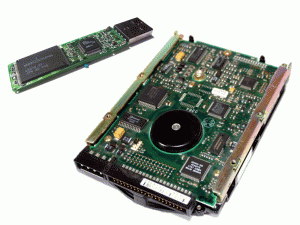
The storage capability of hard drives has been increasing exponentially over the past 60 years. The IBM 350 RAMAC disk released in 1956 was able to store 2000 bits (a unit used to measure storage ability) of information per square inch. In 2014, Seagate Technology released a hard drive that could store 1 billion bits in every square inch. Now only two years later, there is talk of hard drives that can store 1.3 trillion bits per square inch!
To further improve our data storage capabilities, scientists today are working on the development of new materials to store information, such as single molecule magnets. A single molecule magnet is a molecule which can be magnetized using a magnetic field, yet still remains magnetized once the magnetic field is removed. This means that each molecule can contain 1 bit of information, allowing much more storage than the technology in computers today.
In the Chemistry Department at Indiana University, the Smith group has been developing ways to make single molecule magnets using transition metals (metals which reside in the middle of the periodic table), such as iron and manganese. Transition metals are optimal because they often exhibit switchable magnetic properties such as spin crossover and slow magnetic relaxation.
Spin crossover is a phenomenon that changes the spin of one or more electrons from up to down or vice versa. The end result is a change in spin of the overall complex, which allows the metal to store information. Sequences of these metals with varying spin states is akin to binary code (sequences of 1s and 0s read by computers). Spin crossover events can be triggered by light, heat, or in this case, a magnetic field. The lifetime which a complex can hold this information can be measured through the magnetic relaxation, and since we would like our information held for a long period of time, slow magnetic relaxation would be optimal; hence why transition metals are being used for this purpose.

In their recent publication in Chemical Science, the Smith Group discusses their use of an N-heterocyclic carbine-based chelate (we’ll call it the N-chelate for short) to obtain a manganese complex with switchable magnetic properties. So what exactly is an N-chelate, and how does it promote the magnetic properties desired? An N-chelate can be thought of simply as a claw with three prongs, which bind to the metal. This particular claw stabilizes the metal complex and enables the molecule to have magnetic anisotropy. Magnetic anisotropy is a directional dependence on a molecule’s magnetic properties, and is essential for single molecule magnets because it increases the lifetime of magnetization. The end result is a single molecule magnet with a magnetic relaxation on the order of 10-4 seconds. As this is relaxation time is fairly short, research is still ongoing to develop single molecular magnets with much longer relaxation times.
The Smith Group’s manganese based complex is not the first single molecule magnet synthesized, and it most certainly won’t be the last. Beyond manganese, rhenium and nickel as well as several lanthanides have received much attention for potential single molecule magnets since their discovery in 1993. So when will you be able to buy a computer with a single molecule magnet based hard drive? Probably not anytime soon – further research is necessary to strengthen our grasp on single molecule magnets and their potential application in data storage. But when you can, you will be able to store more music, videos, and pictures on your phones and computers without increasing their size.
Edited by Anna Jessee and Maria Tiongco

Leave a Reply